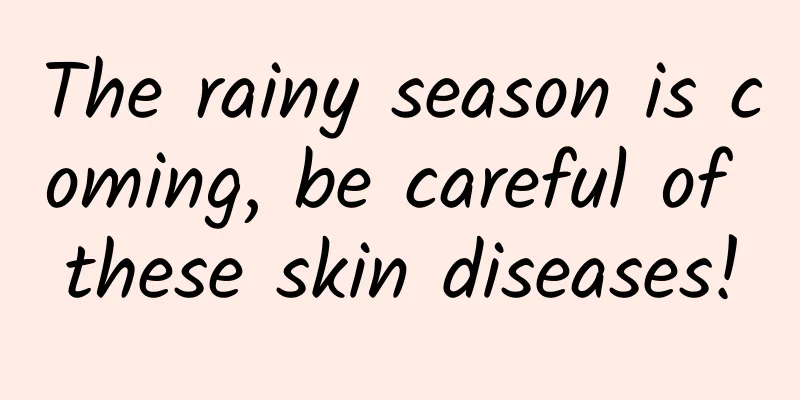The rainy season is coming, be careful of these skin diseases!

|
This is the 4996th article of Da Yi Xiao Hu 1. Fungal skin diseases There are more than 1.5 million species of fungi in nature, from common mushrooms to hard-to-detect dermatophytes. Almost all of them are harmless, but a few can cause serious health problems. Their characteristics: they prefer warm and humid environments, and can only thrive in an environment with a temperature and humidity of 22°C to 36°C, a temperature and humidity of 95% to 100%, and a pH of 5.0 to 6.5 [1]. In this hot summer and the upcoming rainy season, fungal skin diseases are more likely to occur at this time! Skin diseases are often called fungal skin diseases, which can cause minor damage to the skin, mucus, dandruff, and other skin tissues. Fungal diseases can occur in all parts of the body. So, what are the common fungal skin infections? Superficial fungal infection has become one of the urgent issues that need to be focused on in global public health, affecting 20% to 25% of the world's population. You will know it as soon as it is mentioned, such as "athlete's foot" and "onychomycosis". First, let us understand the symptoms of various skin diseases: Tinea cruris is common in the thigh root, characterized by red papules, scaling and itching with clear boundaries; Tinea manuum is characterized by small red blisters, cracks and pain on the palms; Symptoms of tinea pedis include whitening of the skin and blisters between the toes, dampness, exudation and itching on the soles of the feet. Severe patients may develop erysipelas, redness, swelling, burning and pain in the entire foot and even the lower limbs, accompanied by fever; Tinea capitis is characterized by increased sweating, atrophy of hair follicles, and hair loss; Tinea unguium will cause thickening and turbidity of the nails and toenails, and more white flocs between the nails and the flesh. Now, if your skin is already infected by fungi, how can you treat it? And how can you prevent fungal infections? Don’t worry, we can prevent and treat fungal infections, and we can attack and defend against them! 1. Treatment of fungal skin diseases a. Common drugs used for external treatment methods include terbinafine, naftifine, bifonazole/ketoconazole/miconazole/econazole, etc. b. Itraconazole, terbinafine, and fluconazole are three widely used oral antibiotics. But be careful! Please follow the advice of dermatologists for the above drugs and use them reasonably according to your specific disease. 2. Prevention of fungal skin diseases a. It is recommended to change and wash underwear and socks frequently to avoid providing good nourishment and growth conditions for fungi; b. To ensure that clothes and shoes are dry, they should be exposed to the sun. In addition, a little Daknin powder can be sprinkled in the insoles to prevent fungal proliferation; c. Please note that frequent washing of your body should be avoided, as this will damage your skin; d. Do not wear other people’s shoes or hats to prevent cross infection. 2. Insect bite dermatitis (papular urticaria) The summer weather is hot, and the number of mosquitoes increases sharply. In addition, the summer heat exposes more parts of the skin, and there are more chances of being bitten by mosquitoes. Insect bite dermatitis is a type of skin inflammation. Its causes may include: mosquitoes, mites, midges, horseflies, ticks, etc. They can damage the skin, causing erythema, wheals, ulcers, inflammation, and usually a pink urticaria ranging in size from mung beans to peanuts[2]. It may be accompanied by blisters and a strong itchy feeling. It is especially obvious in infants and children, and is more likely to recur[3]. 1. Timely treatment to prevent the disease from prolonging is the principle For those who have obvious itching, it is recommended to apply topical ointments and take oral antipruritic drugs when necessary; if severe skin lesions occur, it is recommended to take short-term immunomodulatory measures, such as prednisone, of course, at this time, a professional dermatologist is required for diagnosis and treatment. If secondary bacterial infection occurs, it is recommended to use ointments containing antibacterial ingredients. Recommendation: If severe itching occurs, it is best to use gentle massage rather than forcibly scratching to avoid skin damage and infection, which will cause the development of the disease. 2. Prevention is the priority, and avoiding contact with the source is the key To stay healthy, we need to keep our surroundings clean. Dry blankets regularly, tidy up the room, and remove possible pests such as cockroaches, lice, and ants. Try not to feed pets and livestock, wear loose and breathable clothing when outdoors, and always carry mosquito repellent. Install window screens or use insecticides to disinfect the surrounding air and soil to inhibit the reproduction of pests [3]. In general, the symptoms of papular urticaria are relatively mild, the course of the disease is relatively short, and it is relatively easy to treat, but because it is prone to recurrence, prevention is very important. 3. Acne Acne, commonly known as pimples, is caused by the warmer weather, increased humidity and exposure to sunlight in the summer, which makes people's skin more vulnerable to damage, and the skin is more prone to increased lipid secretion and bacterial proliferation. Acne usually occurs on the face, chest, upper back or shoulders, where the skin has a higher oil content. It appears as red papules, sometimes with blackheads, lumps and cysts. Some people develop scars during treatment [4, 5]. 1. So how to fight against recurring acne? a. Topical medications, including adapalene gel, benzoyl peroxide cream, metronidazole gel and fusidic acid cream. However, you must not apply them blindly, but need to apply them in spots to allow the affected area to gradually adapt. b. Oral medications: Traditional oral medications such as minocycline or isotretinoin can improve the condition. However, professional diagnosis and dosage must be followed and they must not be used indiscriminately. c. Phototherapy, through various physical treatment methods such as laser, red and blue light, photons, etc., can effectively improve the symptoms of acne, and can be used as an auxiliary treatment option to deal with the sequelae of acne. The above medicines must be used under the guidance of a specialist physician! 2. How to prevent acne from coming back? a. You should try to reduce high-fat, high-calorie foods, especially skim milk. At the same time, you should pay attention to controlling your weight, maintain good living habits, and avoid staying up late and overexposure. b. Learn to control your emotions, because persistent negative emotions may make acne worse. c. Avoid squeezing or picking pimples on your own, as this will more easily leave acne marks and acne pits. d. To keep your skin healthy, it is recommended to use care products containing amino acids to eliminate dirt, bacteria and other harmful ingredients on the skin. When using these products, avoid rubbing or scrubbing vigorously. e. Various skin care products, including foundation, primer, sunscreen and make-up, should be used and selected with care to minimize the resulting acne. Above, we list some common skin diseases in the rainy season. The rainy season is coming, so please pay attention to protection, clean and sunscreen, and avoid mosquito bites. I wish you all enjoy the summer while still having healthy and beautiful skin! References: 1. Tao Disheng, Talking about “fungi” in the plum season. Jiangsu Health Care, 2021(04): p. 10. 2. Tao Tingting, Insect bites? Allergies? Dermatologists talk about annoying papular urticaria. Shanghai Science and Technology News. p. 008. 3. Long Shengzhi, et al., Discussion on the prevention and treatment of papular urticaria in traditional Chinese medicine from the perspective of preventing disease before it occurs. Chinese Journal of Contemporary Medicine, 2024. 31(08): p. 101-105. 4.Narang, I., et al., Seasonal aggravation of acne in summers and the effect of temperature and humidity in a study in a tropical setting. J Cosmet Dermatol, 2019. 18(4): p. 1098-1104. 5.Youn, SW, et al., Regional and seasonal variations in facial sebum secretions: a proposal for the definition of combination skin type. Skin Res Technol, 2005. 11(3): p. 189-95. Author: Yueyang Hospital of Integrated Traditional Chinese and Western Medicine affiliated to Shanghai University of Traditional Chinese Medicine Li Siyu, Li Fulun |
<<: Should I remove the oxygen tube or not?
Recommend
Can you feel the fertilized egg combining?
There is no feeling when the fertilized egg combi...
What is the cause of vaginal lumps?
The vagina is an important reproductive organ for...
Why is the amount of menstrual flow so small?
There are always a few days every month when girl...
Don’t get lost when seeing a doctor | How to seek medical treatment for cardiovascular diseases?
...
Causes of brown discharge
If female friends find that there is brown discha...
What are the characteristics of women's menstrual cycle
Women's menstrual cycle is a cycle, during wh...
Low 25-hydroxyvitamin D
25-Methylvitamin D is a type of vitamin D that is...
What does intramural uterine fibroids mean?
Intramural uterine fibroids are a more common typ...
What harm does accessory breast do to the body?
We have all heard of the term accessory breast. I...
Can women eat strawberries during menstruation?
As we all know, strawberry sprouts are a kind of ...
Why is there brown discharge during late menstruation?
Menstruation can be regarded as a good friend of ...
Is egg yolk pastry a mooncake? What is the white and sticky thing inside the egg yolk pastry?
Egg yolk pastry is a traditional Chinese pastry m...
Why do I have stomach pain after medical abortion?
With the pressure of life and the accelerated pac...
Can an anti-inflammatory diet really prevent cancer? Just eat this way!
Today, let’s talk about a topic that is closely r...
What causes coldness during pregnancy?
A while ago, a friend of mine got pregnant. This ...









